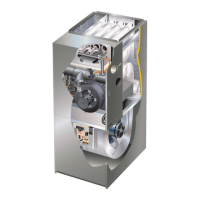ciano
In
systems where the relief valve discharges periodi-
cally,
this
may
be
due to thermal expansion causing pres-
sure build
up.
See "Pressure Build-Up· (Thermal
Expansion)" section.
DISCHARGE LINE TO DRAIN
Figure 3 T&P Relief Valve Test
1.
See "Draining the
Tank"
section to remove water from the
heater.
2.
Turn the electrical supply to the water heater "OFF".
3.
Remove the access door(s) and insulation pad(s).
4.
Disconnect wires from heating element terminals.
5.
Unscrew the element using a 1-1/2
in.
socket wrench or
tool number
S1
008,
available from your water heater dis-
tributor.
6.
Replace element with new one, taking care that sealing
gasket
is
in
the groove of element flange.
7.
Re-connect wiring, and replace Di-Electric shields.
8.
Ensure insulation
pad
is
in
the door cavity. Replace
access door(s).
9.
Fill tank with water BEFORE turning ELECTRICITY
on.
See "Filling the
Tank"
section.
Thermostat
Replacement
1.
Turn the electrical supply to the water heater "OFF".
2.
Remove the access door(s) and insulation pad(s).
3.
Disconnect wires from thermostat(s).
4.
Lift prongs off bracket and slide thermostat
up
and
out.
5.
Replace
in
reverse order, taking care that thermostat(s)
is flush against the tank.
6.
Ensure insulation
pad
is
in
the door cavity. Replace
access door(s).
7.
Turn the electrical supply to the water heater "ON".
Cathodic
Protection:
Anode
Maintenance
Your water heater has been supplied with
an
anode
rod
that
protects the tank from corrosion.
As
the
rod
works, it slow!y
dissolves over time and must
be
replaced. If the anode
IS
less than 10mm (3/8 in.) diameter, or any exposed bare
core, replace. Depending
on
water conditions,
an
anode
can
last from one to ten years. Many localities treat their
water,
which
can
have significant effect
on
the
life.
of your
heater. Water conditioning such
as
over softening can
accelerate the rate at which the anode
rod
is
consumed.
Rapid depletion can leave a heater unprotected causing a
premature failure. As with any water heater, it
is
good prac-
tice to check the anode annually to
see
if it needs replacing.
Anode
Inspection/Change
1.
Turn "OFF" the electrical supply to the tank.
2.
Close the cold water supply valve.
3.
Open a nearby hot water faucet served
by
the system
to depressurize the system.
4.
Connect a hose to the drain valve
and
drain enough
water to empty the piping system
as
directed
in
the
"Draining the
Tank"
section.
5.
Using a 1-1/16
in.
socket, remove the anode and inspect
it.
The surface may
be
rough, full of pits
and
crevices, but
this
is
normal. If it
is
less than approximately 6mm (1/4
in.)
in
diameter, or the inner steel core
is
exposed, the
anode should be replaced.
6.
Apply
Teflon™
tape
or
sealing compounds approved for
use with potable water, to the threads of the anode and
install into the tank top.
7.
Open the cold water supply valve and open a nearby hot
water faucet to purge air from the tank
as
directed
in
the
"Filling the
Tank"
section.
8.
Check for leaks, repair
as
required, and re-test.
9.
Turn "ON" the electrical supply to the tank.
Operating a water heater
without
an actively
working
anode rod
will
void
any warranties, stated
or
implied.
Tank
Clean-Out
1.
A clean-out opening
is
provided
on
certain models for
periodic cleaning of the tank. Power supply must
be
shut
off and the heater drained before opening the clean-out.
2.
To
clean heater through the clean-out opening, proceed
as follows:
a)
Remove outer door from side of the
casin~:
.
b)
Mark the insulation at the
12
o'clock position.
USing
the opening
in
the outer casing
as
a guide cut out the
insulation covering the clean-out flange.
c)
Remove the six (6) hex head screws securing the
tank clean-out plate and remove the plate.
d) Remove lime, scale or sediment using care not to
damage the glass lining of the tank.
-7-

